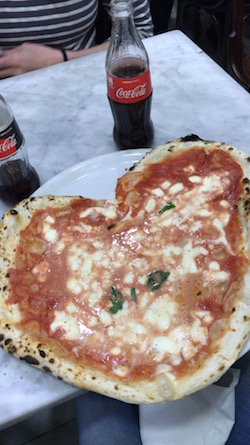Marinara or Margherita?
Coca-Cola, birra or acqua?
That’s how they take your order at L’Antica Pizzeria da Michele in Naples, what some consider to be the best pizza place in the world.
Sure, it doesn’t hurt that this was the pizza Elizabeth Gilbert affectionately described in Eat, Pray, Love, but part of the restaurant’s appeal is also its simplicity. They make two types of pizza in one brick oven and offer three kinds of drinks while you wait.
No menu. No-nonsense decisions. Just happy customers.

So, how can you make your online customers act and feel the same?
By creating content that clearly defines your product or service and motivates behavior.
More specifically, by addressing these four questions and incorporating their answers into your sales and signup pages.
1. Why choose your service over someone else’s?
Framed on the wall next to our table in the pizzeria was the excerpt from Eat, Pray, Love that details Elizabeth’s infatuation with their Margherita pizza. And on adjacent walls were family photos and pictures of celebrities at the restaurant.
These customer memories and stories are like testimonials for their business. They tell visitors what others think of their pizza and how this tradition has been passed down through generations. Together, they bring this famous Napoli experience to life.
So before asking someone to subscribe to your newsletter or buy a pair of your shoes, give your offer some context and let your customers know you are an authority in your industry.
For example, you could include a testimonial from a past customer to show how your product helped solve their problem. Or add a certification badge or award you received to the page as a symbol of your brand recognition.
Bottom line: give them a way to trust your service and assure them you are the best solution to their problem.
2. What exactly are you offering?
At the pizzeria, everyone around us was at various stages of digging into their pizza so we knew exactly what to expect. Plus, the smells coming from the brick oven were so divine you could almost taste the dough.

Even though your website can’t capture your customer’s senses the same way, it can use descriptive writing and visuals to tell them what your sofa feels like, how it looks inside a living room, what it’s made of, etc.
Similarly, a sales page dedicated to purchasing your e-book can include a picture of its front cover or a sneak preview of its opening chapter. The landing page could also include a table of contents and a summary of what the publication is about.
In other words, the more tangible you can make your offer, the better.
3. How will it make your customer’s life better?
The pizzeria has it easy here because when does pizza not make life better?
In all seriousness, spelling out the benefits of purchasing your product or signing up for your service is a crucial part of getting your customer to say yes. There are many ways to illustrate the value your solution provides, but these questions are a good place to start:
- What positive outcomes will your customer gain from this purchase or expert knowledge?
- How will your product or service make your customer feel?
- Is there research or data that backs up your user-friendly software or posture-correcting pillow?
This is where case studies and glowing customer reviews can help convince others to take the next step. If favorable stats support your business idea or people have flattering things to say about their experience using your service, put them next to the offer.
Remember, real-life examples and scientific evidence are great ways to reassure your customer that your product works.
4. Is it super easy for your customer to take the next step?
As you’ve gathered by now, the pizzeria couldn’t have made it easier for you to order a pizza pie. So easy in fact, I sort of wish every lunch order was that uncomplicated.
That’s the goal you should shoot for when creating a call to action (CTA)—keep it simple and specific so there’s zero confusion on what to do next. Visually and verbally, your CTAs should stand out on the page and clearly lead the visitor to sign up or complete a transaction. More on how to do that here.
So the next time you offer a solution to your audience, don’t leave them in limbo, wondering whether they should say yes. Instead, show off your specialized experience, help them visualize your product, spell out the benefits and take them directly to the next step.
Serve them an irresistible slice of your business and they won’t be able to say no.
